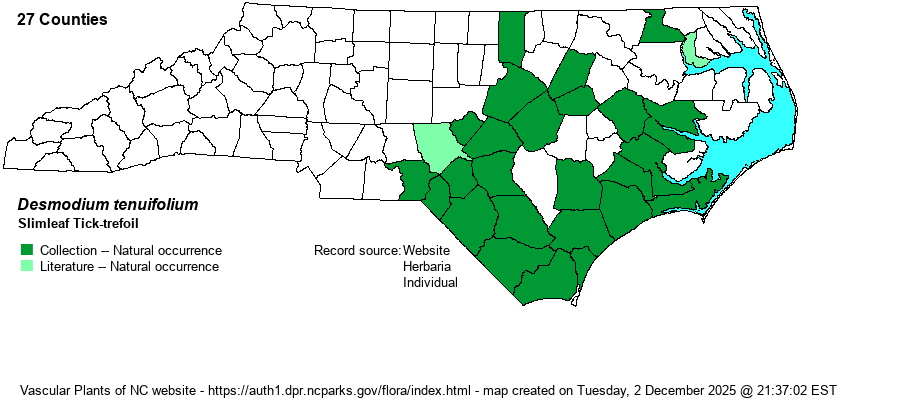| Author | Torrey & A. Gray | |
| Distribution | Throughout the southern 60% of the Coastal Plain, including the Sandhills region. Only a few scattered records for the northern and northeastern part of the Coastal Plain. A record for Granville County, in the eastern Piedmont, is perhaps the only one for that province.
This is a Coastal Plain species, ranging north only to southeastern VA, and then south to central FL and west to far eastern TX. | |
| Abundance | Fairly common to common in the Longleaf Pine (Pinus palustris) belts from Croatan National Forest (Craven County) to Brunswick County and in the Sandhills region. Infrequent to at least locally fairly common in the central portions of the southern Coastal Plain, and in the central parts of the province; very rare in the northern portions. Casual in the far eastern Piedmont. | |
| Habitat | This is a moist to wet soil species of pine savannas, pine flatwoods, streamhead pocosins, and seepages. Hardly any other Desmodium species is limited to wetlands in the state, though "wetlands" really means damp ground and not truly wet places (marshes, swamps, etc.). | |
| Phenology | Blooms from July to August, and fruits from September to October. | |
| Identification | This specie of Desmodium has very slender leaflets and looks quite similar to another Coastal Plain species -- D. strictum. Each is an erect species growing to 2-3 feet tall, and each has 3 very narrow, linear leaflets, to about 1.5 inches long and barely 1/5-inch wide. Each has somewhat short but distinct petioles of about 1/4-inch long; the now historical D. sessilifolium of the central Piedmont has the leaves essentially sessile (as the name suggests). Each also has rather striking long and broad panicles of pink flowers, though each flower is only about 1/5-inch long. The two differ by pod characters and habitat. In D. tenuifolium, the top (suture side) of each pod is rounded at each of the several loments (segments), whereas in D. strictum the top of the pod is flat; in each the lower end is strongly rounded around each segment. D. tenuifolium grows in savannas, wet pine flatwoods, seepage slopes in the Sandhills, pocosin ecotones, and other damp acidic ground. On the other hand, D. strictum grows in dry sandy places, usually in dry pinelands or in pine/scrub oak sandhills, and of course in sandy spots in openings, along edges, and other disturbed ground. This species should be readily found in many of the protected savannas and flatwoods in southern coastal counties, and it can be readily found in the Sandhills in damp, boggy places, but there it is clearly outnumbered by the upland D. strictum. | |
| Taxonomic Comments | None
| |
| Other Common Name(s) | None | |
| State Rank | S3? [S4] | |
| Global Rank | G4 | |
| State Status | | |
| US Status | | |
| USACE-agcp | FACU link |
| USACE-emp | FAC link |

